
M.D., Ph.D. Professor Dai Watanabe
Understanding of the brain is the greatest frontier in life science and medical research. The field of neuroscience has made enormous progress over the past several decades. However, the basic principles of brain function and cognition remain only partly understood. To open the new horizons in this research field, passion and imagination of young people are indispensable. We welcome young students, and hope we can work hard together and develop innovative techniques and novel ideas to solve the complexities of the brain and the mysteries of our mind.
Research and Education
The brain is the most complex thing we have yet discovered in our universe. This single organ controls all the body activities, including heartbeat, breathing, appetite, sleep and sexual function. The brain produces our ability of sensory perception, motor action, learning and memory; it shapes our emotions, thoughts and behaviors. Importantly, from medical point of view, more than 1,000 brain disorders result in more hospitalizations and lost productivity than any other disease group, including heart disease and cancer.
Our laboratory address how trillions of brain cells grow and organize themselves into functional systems. We also study how factors during early development and aging cause brain dysfunction. To achieve this, we utilize various techniques such as molecular biology, electrophysiology, imaging, gene manipulation of living animals, behavioral analysis and gene profiling. Currently, we focus our research on the neural circuits involved in complex behavioral skills that are acquired through social interaction. Our studies will facilitate the understanding of high-order brain functions such as human language.
 Live cell imaging of neuronal activity in a freely behaving animal during the cognitive-learning tasks.
Live cell imaging of neuronal activity in a freely behaving animal during the cognitive-learning tasks.
 Laboratory members
Laboratory members
Recent Publications
- Nishioka T, Hamaguchi K, Yawata S, Hikida T, Watanabe D. Chemogenetic suppression of the subthalamic nucleus induces attentional deficits and impulsive action in a five-choice serial reaction time task in mice. Frontiers in Systems Neuroscience 14:38 2020.
- Okunomiya T, Hioki H, Nishimura C, Yawata S, Imayoshi I, Kageyama R, Takahashi R, Watanabe D. Generation of a MOR‐CreER knock‐in mouse line to study cells and neural circuits involved in mu opioid receptor signaling. Genesis e23341 2019.
- Abe K, Matsui S, Watanabe D. Transgenic songbirds with suppressed or enhanced activity of CREB transcription factor. PNAS 112:7599-7604 2015.
- Fujimoto H, Hasegawa T, Watanabe D. Neural coding of syntactic structure in learned vocalizations in the songbird. J Neurosci 31:10023–10033 2011.
- Abe K, Watanabe D. Songbirds possess the spontaneous ability to discriminate syntactic rules. Nat Neurosci 14:1067–1074 2011.
Laboratory
[Professor] Dai Watanabe
[Senior Lecturer] Kosuke Hamaguchi
[Assistant Professor] Satoshi Yawata
[Assistant Professor] Chika Nishimura
TEL: +81-75-753-4437
FAX: +81-75-753-4404
e-mail: dai@phy.med.kyoto-u.ac.jp
URL: https://phy.med.kyoto-u.ac.jp/
